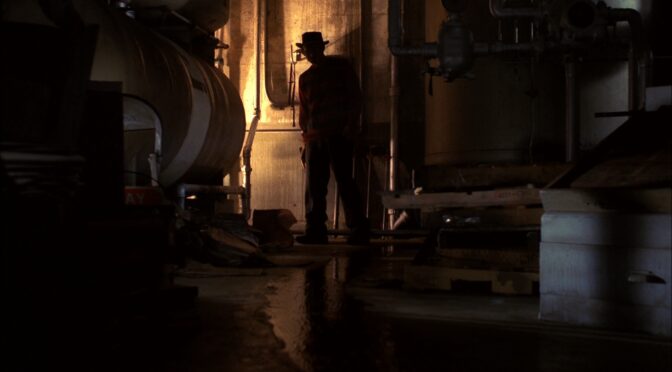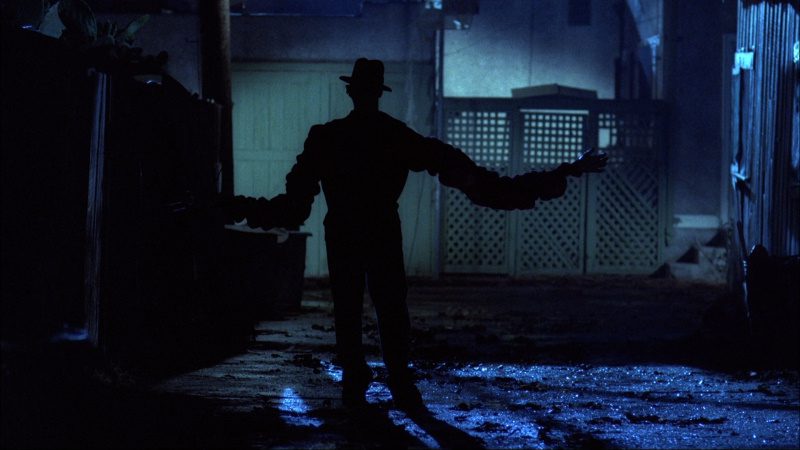“Nine, ten, never sleep again…”
A Nightmare on Elm Street is the rare classic horror film that actually deserves its classic status. Horror is a strange genre because so often “old” gives way easily to “classic” (see: Friday the 13th), but Nightmare holds up because not only did writer-director Wes Craven create one of horror’s most enduring villains, he found a way to make audiences feel unsafe anywhere they went.
Beds are supposed to be safe. Beds in your own home are fortresses. Nothing bad can happen to you there – the monsters underneath are trapped, and the ones in your closet find themselves unable to breach the safety of your comforter (hell, we even call a big sheet a comforter). You might have nightmares, but waking up in your own bed restores a sense of normalcy and sanity. A Nightmare on Elm Street perverts all that. Not only are you not safe in your bed, you aren’t safe anywhere you sleep.
The plot is pretty straightforward, and almost doesn’t bear repeating. A group of teenagers have all been having nightmares about the same monster with knives for fingernails: Freddy Krueger, played by Robert Englund when he was still allowed to be scary and not just spout one-liners. (In the credits Krueger is called “Fred Krueger,” which I found hilariously formal. “Please, call me Freddy; Fred Krueger was my father’s name.”) Freddy is at first only shown in shadow, skulking in the bowels of a boiler room, his cackle bouncing off the walls.
Nightmare would be just another mindless slasher flick if we didn’t care about the kids involved, but Craven’s film surpasses Friday the 13th (my new go-to overrated horror movie) by bothering to actually define its characters. The body count is surprisingly low – only two deaths by the sixty-minute mark – which makes the stakes feel higher.
Amanda Wyss does fine work as Tina; it’s a pretty small part, but Wyss manages to make Tina vulnerable while still displaying the spunky attitude of invincibility that’s unique to teenagers. Johnny Depp, making his film debut as Nancy’s boyfriend Glen, shows some real star quality, and turns in an impressively mature performance that shows glimpses of his young-Brando charisma and sensuality. It’s Heather Langenkamp, though, who walks away with the movie, in the role of Nancy. (Another way in which Nightmare beats Friday is that it easily pulls off the bait and switch that Friday attempted; we meet Tina first, but after she dies the film segues cleanly into following Nancy.) It’s a testament to Langenkamp’s screen presence that she can share the screen with Freddy Krueger and we still want to pay attention to her, not the monster – she’s funny, smart, and determined, and she flat-out refuses to die. And of course, there’s Englund; he has a hall-of-fame evil laugh, and even though there’s a smile perpetually plastered on his ghoulish visage, it does little to mask the undercurrent of real, tangible hate that fuels all of Freddy’s attacks.
Not all of the casting is a slam-dunk, though. Jsu Garcia (credited as Nick Corri) plays Rod, Tina’s boyfriend who ends up suspected of her murder, and throughout the film he acts like a tough guy in an after-school special. It’s like Corri saw Jeff Conaway as Kenickie in Grease, said “Yep,” and decided to just do that. Also, all of the adults in Nightmare are hilariously awful people. At one point Nancy’s mother says to her, “Maybe you just don’t take murder seriously” (the day after her best friend’s murder, mind you), and her father almost kills her through outright negligence in the finale. The film’s score by Charles Bernstein is nearly omnipresent, which can be distracting and gives the film very little breathing room.
But I consider all those to be minor issues with Craven’s film, because he creates some images here that are truly nightmarish (excuse the pun). The transitions from waking to dreaming life are presented seamlessly, which allows Craven to excellently utilize images like Tina in a bloody body bag, beckoning to Nancy, or Freddy’s arms growing to impossible lengths. Nightmare is a marvel of practical effects, which keeps the film from feeling dated (1980s CGI hasn’t aged particularly well). At one point, the ceiling above a sleeping Nancy starts stretching outwards, allowing us to see the outline of Freddy’s face and hands, and beyond being a cool effect it’s a good way to demonstrate Craven’s technique of blurring dreams with reality. Beds feature prominently in all the deaths portrayed, as if to underscore Craven’s message. It’s also a way for the effects team to have a lot of fun – a bedsheet twists its way around Rod’s neck before hanging him from the ceiling, and Glen’s bed swallows him whole before belching out a geyser of blood, as if Freddy is showing appreciation for a good meal.
Near the end of the film, I started thinking what a good survival horror game you could make out of A Nightmare on Elm Street. The goal is to keep yourself awake, but you have no way to gauge if you’re succeeding. You run the risk of falling asleep at random intervals, and just like in Craven’s film, there will be no clear indicator that you’re dreaming. Then you have to wake yourself up, run from Freddy, fight Freddy, or die. This is a somewhat roundabout way of saying that Craven created a world in Nightmare that is so eerie and engaging that I started to wonder what it would be like to live in it.
10/1: Dawn of the Dead (2004)
10/2: The Exorcist
10/3: Pontypool
10/4: Hocus Pocus
10/5: The Orphanage
10/6: Rosemary’s Baby
10/7: Alien
10/8: Scream series
10/9: Scream series
10/10: Cujo
10/11: The Cabin in the Woods
10/12: Pulse
10/13: The Babadook
10/14: Friday the 13th
10/15: The Last House on the Left (both versions)
10/16: The Thing (both versions)
10/17: Little Shop of Horrors
10/18: Hush
10/19: Silent Hill
10/20: The Shining
10/21: Funny Games (2007)
10/22: Evil Dead series
10/23: Evil Dead series
10/24: The Mist
10/25: The Ninth Gate
10/26: The Fly
10/27: A Nightmare on Elm Street
10/28: The Nightmare Before Christmas
10/29: 28 Days Later/28 Weeks Later
10/30: It
10/31: Halloween (either version)



